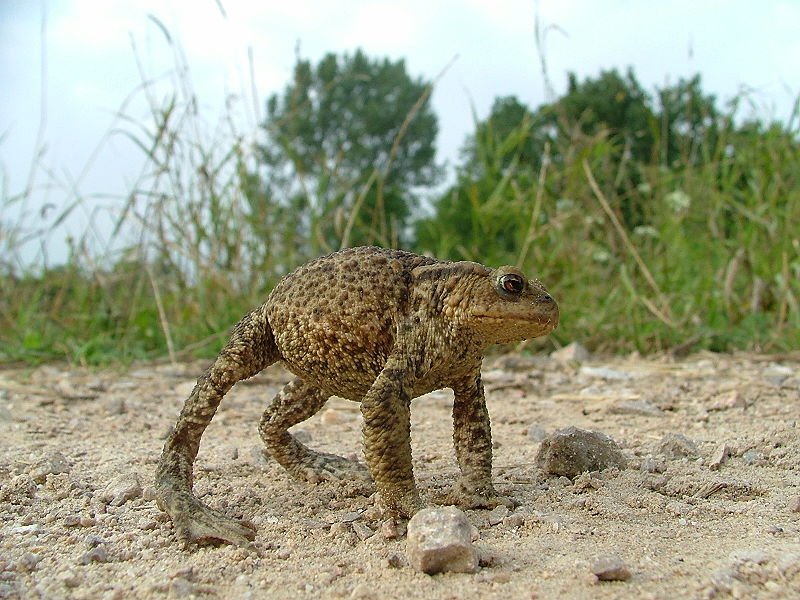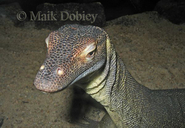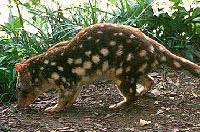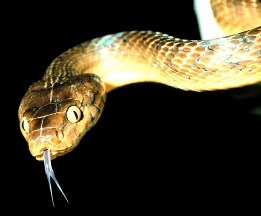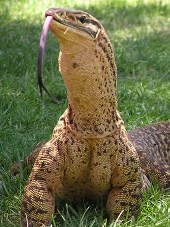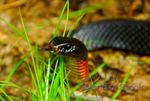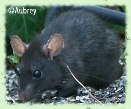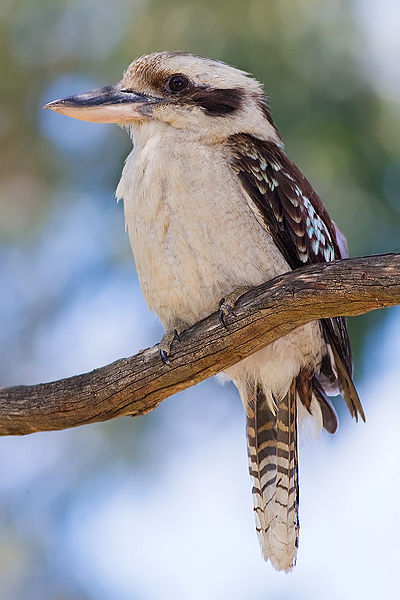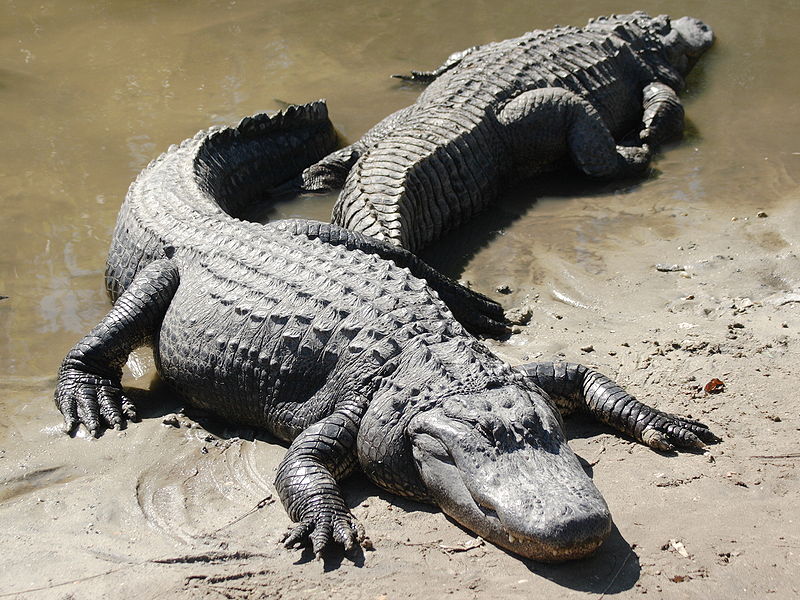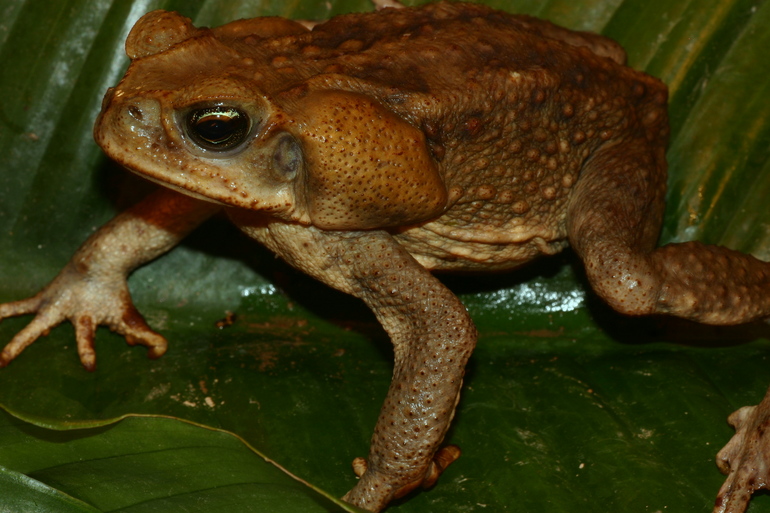The Most-Traveled Cane Toad
Poisonous Toads!

Of course I advocate that you just read straight on down the page, but if you're crunched for time, here's a partial list of questions answered (and bookmarked) on this info-rich page:
Tell me about the cane toads' poison.
Species downed by the cane toad.
Do cane toads poison themselves?
Toxicity through the lifecycle.
The entire Bufonidae family has some degree of toxins. The cane toad is an exceptional standout within its family, and has been described as a “hopping cocktail of cardio-active substances” (qtd in Lever pg 29). The toad actually produces several different chemicals. One is similar to the drug digitalis, and results in the heart entering ventricular fibrillation --a dysfunctional, uncoordinated beat pattern that, untreated, results in death. The parotid or paratoid gland, which is behind their ear (“parotid” means “near the ear”), is the source of the toxin. Interestingly, skin cells act as a cork to plug the duct which releases the toxin. When stressed, the toad can increase the pressure inside the duct until the toxin is so pressurized that it dislodges the plug and toxin shoots from the gland. The gland can project toxin up to several meters (9 feet)! However, toads prefer to hop away or assume threatening stances rather than shoot their poison.
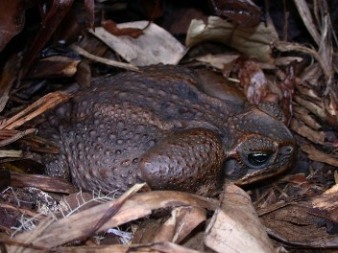 In
the photo to the left, note the large poison gland
(called the parotid gland). It is
the huge swelling behind his ear (in case you don't know frog
ears, the ear is the round circle behind his eye). The
gland continues to amass more poison over time, and so older
toads are more toxic than smaller, younger toads. Just
don't dislodge a plug on the poison!
In
the photo to the left, note the large poison gland
(called the parotid gland). It is
the huge swelling behind his ear (in case you don't know frog
ears, the ear is the round circle behind his eye). The
gland continues to amass more poison over time, and so older
toads are more toxic than smaller, younger toads. Just
don't dislodge a plug on the poison!
People can die within 15 minutes of getting
poisoned by a cane toad. Due to their size,
children are more affected by the poison than are adults.
The toxin affects blood pressure, breathing, and the
beating patterns of the heart, and can cause paralysis,
salivation, and vomiting. People may get
poison shot into thei r eyes while dealing with the toads.
While the toads are generally sedate and rather tolerant
of human handling, occasionally the toads feel threatened enough
to blow a poison plug. Also, poison may shoot
if a toad is shot or beheaded. The presence
of toad toxin in the eye is extremely painful and can result in
a temporary or more permanent loss of vision.
The toxin is a skin irritant, but it doesn’t
efficiently pass through the skin and into the body – but it can
pass through cuts in the skin.
r eyes while dealing with the toads.
While the toads are generally sedate and rather tolerant
of human handling, occasionally the toads feel threatened enough
to blow a poison plug. Also, poison may shoot
if a toad is shot or beheaded. The presence
of toad toxin in the eye is extremely painful and can result in
a temporary or more permanent loss of vision.
The toxin is a skin irritant, but it doesn’t
efficiently pass through the skin and into the body – but it can
pass through cuts in the skin.
By far the most problematic
toad poisoning are those when the toxin is swallowed.
You may be thinking, “How or why do people ingest toad
toxin?” That’s a good question with a
very
interesting answer. First
consider that there exists enough of these absurd-minded
individuals who would choose to use the toxin that
 Some people intentionally
kill and boil a toad, then drink the resulting solution.
This is a very dangerous pastime, but the toad tea is
hallucinogenic. Teens, thinking that toads
may have an effect analogous to illicit drugs, sometimes take a
small (hopefully small enough to not be deadly!) lick of the
toad’s back, where some poison residues exist.
In
Some people intentionally
kill and boil a toad, then drink the resulting solution.
This is a very dangerous pastime, but the toad tea is
hallucinogenic. Teens, thinking that toads
may have an effect analogous to illicit drugs, sometimes take a
small (hopefully small enough to not be deadly!) lick of the
toad’s back, where some poison residues exist.
In
Consider the true story of an indigenous family and toad soup:
“…[they] gathered numerous strings of toad eggs from a nearby marsh and had then boiled them in water, which the family all drank; the mother and sister drank most of the “soup”…the uneaten portion was given to the domestic fowl and pigs, and after a period of about half an hour one of the pigs was seen to be retching. The girl experienced pain in her stomach and her mother, who by this time realized what they had consumed, said that they would all die. Some two hours later all four members of the family began to vomit, and the surviving girl complained of muscle spasms and a sensation of burning and pain over her lips. Her mother and sister had become prostrate, their fingers and lips had turned blue, and pustules had formed on her sister’s lips. The abdomens of both the mother and sister had become bloated, and their bodies were hot and rigid. They were pronounced dead…some four hours after ingesting the “soup”…[authorities] believed that death was due to cardiac seizure preceded by respiratory difficulties.” (Lever 31).
In areas where the toads are native, the indigenous people are well aware of the cane toads’ toxins. These toxins are sometimes used in religious ceremonies for their hallucinogenic effects, or as poisons for hunting. The Olmec either used the poison as a narcotic or ate the toads after removing the toxic components: the skin and glands. The Colombian Choco Indians milked the toads over hot fires, and the Mexican Amerindians used hot rocks to milk the toads, and both groups used the resulting toxins on hunting arrow
Humans aren’t the only species
troubled by
toad poison. In
You might be wondering
if the toads toxify
themselves…Judging from the huge
toad populations, the toxins
obviously don’t bother the toads. Science has
discovered that toads are resistant to their own toxins; if
anything, a toxified toad may become sluggish – but not lethally
so!
Toads are toxic throughout their lives. They are toxic as eggs, as tadpoles, as toadlets, and as adults. They are least toxic as metamorphs (transitioning from a legged tadpole to a toadlet), and in fact this is when most predation of cane toads occurs. Toadlets lack big parotid glands and thus have less toxin. Interestingly, the presence of even large quantities of toads in a body of water does not toxify the water for most species; the toxins are mostly self-contained.
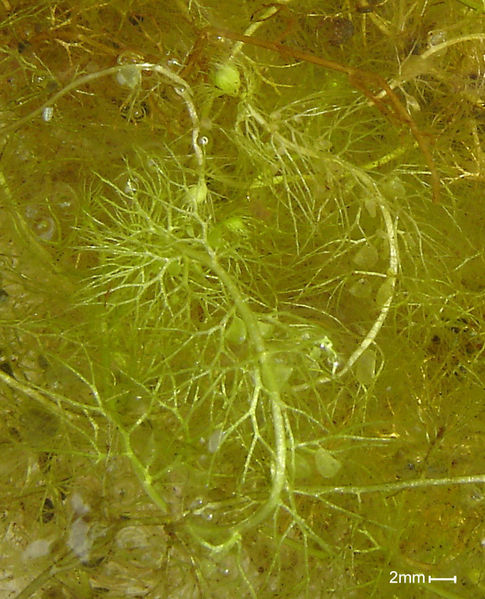 There are some
predators for cane toads.
This is especially true in their native habitats, but
partially true even in habitats in which they are exotic.
Predators include snakes, water rats, water beetles,
various birds, turtles and tortoises, crayfish, crocodiles,
eels, monitors, and giant centipedes. Even a
plant, the insect-devouring bladderwart (this is analogous to a
venus fly trap) eats tadpoles. Some
Australian birds, among them black kites, flip the toads onto
their backs so that their soft and non-toxic bellies are exposed
for eating – the poison glands are on the backside, so this is
perfectly safe. Crows have been known to move
road-killed cane toads into puddles to hydrate, after which they
eat toad bellies.
There are some
predators for cane toads.
This is especially true in their native habitats, but
partially true even in habitats in which they are exotic.
Predators include snakes, water rats, water beetles,
various birds, turtles and tortoises, crayfish, crocodiles,
eels, monitors, and giant centipedes. Even a
plant, the insect-devouring bladderwart (this is analogous to a
venus fly trap) eats tadpoles. Some
Australian birds, among them black kites, flip the toads onto
their backs so that their soft and non-toxic bellies are exposed
for eating – the poison glands are on the backside, so this is
perfectly safe. Crows have been known to move
road-killed cane toads into puddles to hydrate, after which they
eat toad bellies.
As to the other predators, the ones other than birds, I'm really not sure how they survive the cane toad. I suppose the bladderwart, being a plant, isn't susceptible to heart attacks. Perhaps the beetles, water bugs, water rats and some other species don't eat a whole cane toad at a time, and maybe the lucky individuals who started on the belly of the toad become satiated before moving on to the more poisonous backside. But I don't know! Even some venomous snakes have lost the gamble of eating cane toads, and so maybe the ones that do successfully eat the toad simply have some tolerance or mechanism to cope with the toxin.
How do toads become toxic? Like many species that contain toxins, the toads acquire the foundational toxin compounds from their diet. The compounds are then metabolized and converted into toxin, and stored in the parotid gland. So the toads eat the “ingredients”, mix and bake those ingredients into a toxic product, and store their masterpiece until toxins are needed.
Again, the toads sure look innocent!
Are poisonous creatures your delight? You can learn about other poisonous organisms through multipleorganisms.net -- for example, the cottonmouth. Only AFTER reading everything possible about the cane toad, of course. Cane toads are surely more interesting, and so let's learn how to go about toad identification.
